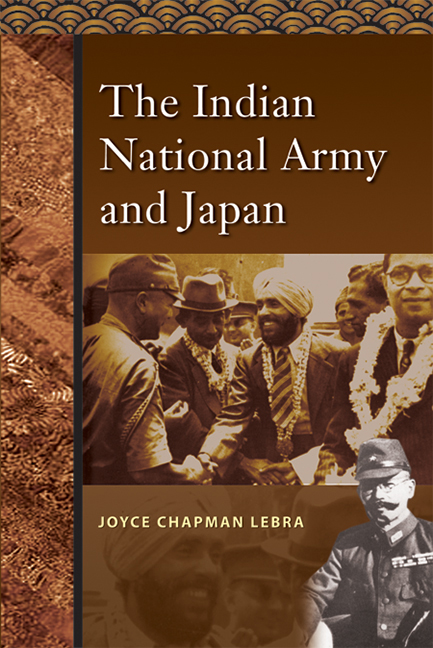Book contents
- Frontmatter
- Contents
- Illustrations and Maps
- Abstract
- Foreword
- Preface
- Acknowledgements
- Introduction
- 1 Mission to Bangkok
- 2 Malayan Jungle Meeting
- 3 Singapore Capitulates and the INA Blossoms
- 4 Tokyo Conference
- 5 Japanese Policy toward India
- 6 The Crisis of the First INA
- 7 Subhas Chandra Bose, Hitler, and Tōjō
- 8 Bose, the FIPG, and the Hikari Kikan
- 9 To India or Not?
- 10 The Rising Sun Unfurls; the Tiger Springs
- 11 A Plane Crash
- 12 A Trial in the Red Fort
- 13 Retrospect
- Notes
- Bibliographical Note
- Bibliography
- Index
- About the Author
Foreword
Published online by Cambridge University Press: 21 October 2015
- Frontmatter
- Contents
- Illustrations and Maps
- Abstract
- Foreword
- Preface
- Acknowledgements
- Introduction
- 1 Mission to Bangkok
- 2 Malayan Jungle Meeting
- 3 Singapore Capitulates and the INA Blossoms
- 4 Tokyo Conference
- 5 Japanese Policy toward India
- 6 The Crisis of the First INA
- 7 Subhas Chandra Bose, Hitler, and Tōjō
- 8 Bose, the FIPG, and the Hikari Kikan
- 9 To India or Not?
- 10 The Rising Sun Unfurls; the Tiger Springs
- 11 A Plane Crash
- 12 A Trial in the Red Fort
- 13 Retrospect
- Notes
- Bibliographical Note
- Bibliography
- Index
- About the Author
Summary
It is a quarter of a century ago that Japanese armed forces left Southeast Asia, yet even now our knowledge about the occupation years can be likened to a jigsaw puzzle in which far too many pieces are still missing. Happily, the number of researchers devoting themselves to the study of wartime Southeast Asia is increasing. More than that, many if not most of them are better trained than the handful of scholars who preceded them. Thus, though there are entire countries about which we know as yet lamentably little, others, or parts of others at least, have emerged into ever-clearer perspective. This is particularly true of what might be called “macro-political” studies, which focus on the centres of political and administrative power, if not also on the largest, or dominant, population groups. Far less is known about regional and local developments beyond the capital cities, about smaller ethnic groups and, at least equally important, about racial minorities. It is surely remarkable that no monograph on the Chinese in wartime Southeast Asia has yet appeared, and that in spite of the highly complex relationships between Nanyang Chinese and Japanese.
The more fortunate, then, that we now have before us the first detailed study by a Western scholar of the second largest alien Asian minority in Southeast Asia, the Indians. It most ably supplements and complements K. K. Ghosh's The Indian National Army: Second Front of the Indian Independence Movement, published in India in 1969. Indeed, Dr Lebra's major concern is not with the Indian communities in Malaya, Burma and Thailand as such. Rather, it is with a peculiarly fascinating and turbulent chapter in modern Indian history—a history that happened for the greater part to take place in Southeast Asia (some of it of course also in Japan and one agonizing moment even in India proper). And though several prominent Indian residents in the region played a far from negligible part in the events of the 1940s, which also involved tens of thousands of their local compatriots, the real leadership lay with others.
- Type
- Chapter
- Information
- The Indian National Army and Japan , pp. viii - xPublisher: ISEAS–Yusof Ishak InstitutePrint publication year: 2008

